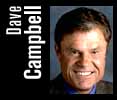 |
| Thursday, August 15 Updated: August 17, 1:15 PM ET Strike would be catastrophic for baseball By Dave Campbell Special to ESPN.com |
||||||||||||||||||||||
|
Because of 9/11, the owners and players know they must find common ground and avoid a baseball strike. People across this country -- baseball fans included -- won't tolerate another strike. Post 9/11, the climate in this nation is drastically different than in 1994. Some Americans have lost their life's savings in the stock market. Do you think anyone will feel sympathy for baseball players who strike despite an average salary of $2.38 million? Given these realities, a strike would be a disaster for baseball.
Drug Testing Complexity In fact, I read a report recently that said the U.S. Olympic Committee has acknowledged it won't be able to test for human growth hormone until after the 2004 Olympics. The drug is a synthetic form of a hormone naturally produced by the pituitary gland, so it can't be detected. It's injected at a cost of $2,000 per month (more than affordable at that $2.38 million salary). One doctor estimates there are 300,000 to 500,000 users nationwide. So while the percentage of players taking steroids is probably minimal, if you count human growth hormone, the numbers would rise. But since there's no way to prove who's taking it, drug testing is almost a moot point.
Art of Negotiation If the sides can't agree, it will go down as one of the worst moments in the history of labor negotiations. How can you not compromise on a way to divide $3.5 billion? Especially when the average worker makes $2.38 million! That won't fly with fans anywhere. If a strike occurs, players and owners alike would get scorched in the press and the net result would likely be a mass exodus among baseball fans. This time, fans would be even angrier because of the approaching anniversary of 9/11. If there's no settlement, it would be catastrophic for the game.
Keep An Eye On These Baserunners
To be a good basestealer, a 75 percent success rate is the benchmark. In this day and age of high-octane offense, you're running your team out of innings if you're less successful than that. Following are my lists of the five best baserunners and basestealers and the five fastest guys in baseball (in alphabetical order):
Five Best Baserunners
Five Best Basestealers
Five Fastest Guys
Move to Rotation Could Help Foulke Starting could be something of a safety net for Foulke. He needs to regain his confidence. And it isn't as if the White Sox have five lights-out starters. They could use September to give him several starts to see how it goes. If it doesn't work, he could always return to the bullpen in the spring. There's a financial aspect to this, too. Starters usually have longer careers and make more money. Mariano Rivera is baseball's best-paid closer at $44 million over four years ($9.45 million this year). But that's far less than the contracts of starters like Kevin Brown ($15.7 million this year), Greg Maddux ($13.1 million) and Pedro Martinez ($14 million).
If I Were The Skipper...
Campbell's Call
This reminds me of Kevin Millwood's situation in 1999, his second full year with the Atlanta Braves. Counting the '99 postseason, Millwood pitched 70 more innings than he'd ever pitched before, which deadened his arm for the past two-and-a-half years. The statistics bear this out: In '99, Millwood was 18-7 with a 2.68 ERA. But his numbers in 2000 (10-13, 4.66) and 2001 (7-7, 4.31) reflect a dead arm. This year, his arm has bounced back (11-6, 3.38). So more power to the Cubs for protecting Prior.
Ballpark Focus: Edison Field, Anaheim Angels Edison Field is more of a pitcher's park earlier in the season and more of a hitter's park as the season progresses. The ball carries better in July, August and September than earlier in the season, when the air is heavier. Likewise, from April through early July, the field is somewhat spongy because of the damp night air. But as the summer heats up with its 90-degree days, it bakes the field and makes the infield clay harder. A similar phenomenon occurs at Dodger Stadium. There are no real idiosyncrasies that I'm aware of. It's essentially a symmetrical park. Balls coming off the wall in right-center can take an occasional crazy carom, but that's about it. Edison has a comfortable feel to it. The Angels took the old ballpark, put $115 million into it and made it a fan-friendly park. Editor's Note: All statistics are through Wednesday's games. Dave Campbell, who was an infielder for eight seasons in the major leagues (1967-74), is an analyst for Baseball Tonight and ESPN Radio. |
| |||||||||||||||||||||



 Dan Patrick Show
Dan Patrick Show In Position
In Position